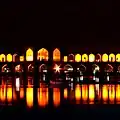郝久古桥
郝久古桥 (波斯語: Pol-e Khāju) 是伊朗伊斯法罕的一座桥梁,被誉为伊斯法罕省最优秀的桥梁。[1]

郝久古桥
它是由波斯萨非王朝国王阿拔斯二世于1650年左右,兴建在旧桥的基础上。它连接北岸的郝久区和Zayandeh河对岸的拜火教区。它不仅是桥梁和水坝,还是一座建筑[2],为公众集会的场所。[1] 最初它装饰着艺术瓷砖和画作,用作茶馆。在建筑的中心,里面有一个凉亭,阿拔斯国王曾坐在这里,欣赏美景。[1] 这座桥是萨非王朝时期波斯建筑最好的例子之一。用厄珀姆·波普和让·夏尔丹的话说,郝久古桥是“波斯桥梁建筑的终极纪念碑和现存最有趣的桥梁之一...这里的整体具有节奏感,结合了最幸福的一致性:实用,美观和娱乐”[3]
郝久古桥有24个拱门,长133米,宽12米。现有的铭文表明,大桥于1873年修复。
亚瑟·厄珀姆·波普和他的妻子菲利斯·阿克曼的陵墓就在附近。
图片
 夜景
夜景 夜景
夜景 夜景
夜景 夜景,突出拱门
夜景,突出拱门 亚瑟·厄珀姆·波普和菲利斯·阿克曼的陵墓
亚瑟·厄珀姆·波普和菲利斯·阿克曼的陵墓
注释
参考
- Blair, Sheila S. and Jonathan M. Bloom. 1994. The Art and Architecture of Islam. New Haven: Yale University Press.
- Michell, George. 1978. Architecture of the Islamic World. London: Thames and Hudson.
- More Picture، Tishineh (页面存档备份,存于)
This article is issued from Wikipedia. The text is licensed under Creative Commons - Attribution - Sharealike. Additional terms may apply for the media files.